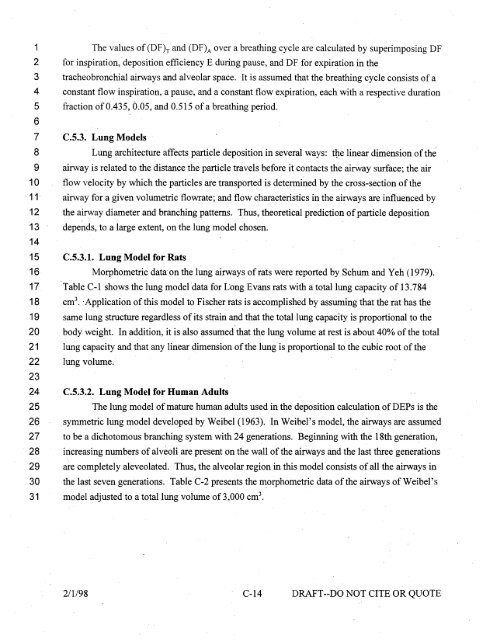Health Assessment Document for Diesel Emissions - NSCEP | US ...
Health Assessment Document for Diesel Emissions - NSCEP | US ...
Health Assessment Document for Diesel Emissions - NSCEP | US ...
Create successful ePaper yourself
Turn your PDF publications into a flip-book with our unique Google optimized e-Paper software.
1 The values of (DFh and (DF)A over a breathing cycle are calculated by superimposing DF<br />
2 <strong>for</strong> inspiration, deposition efficiency E during pause, and DF <strong>for</strong> expiration in the<br />
3 tracheobronchial airways and alveolar space. It is assumed that the breathing cycle consists of a<br />
4 constant flow inspiration, a pause, and a constant flow expiration, each with a respective duration<br />
5 fraction of0.435, 0.05, and 0.515 of a breathing period.<br />
6<br />
7 C.5.3. Lung Models<br />
8 Lung architecture affects particle deposition in several ways: t\le linear dimension of the<br />
9 airway is related to the distance the particle travels be<strong>for</strong>e it contacts the airway surface; the air<br />
1 0 flow velocity by which the particles are transported is determined by the cross-section of the<br />
11· airway <strong>for</strong> a given volumetric flowrate; and flow characteristics in the airways are influenced by<br />
12 the airway diameter and branching patterns. Thus, theoretical prediction of particle deposition<br />
13 depends, to a large extent, on the lung model chosen.<br />
14<br />
15 C.5.3.1. Lung Model <strong>for</strong> Rats<br />
16 Morphometric data on the lung airways of rats were reported by Schum and Yeh (1979).<br />
17 Table C-1 shows the lung modeldata <strong>for</strong> Long Evans rats with a total lung capacity of 13.784<br />
18 cm 3 • ·Application of this model to Fischer rats is accomplished by assuming that the rat has the<br />
19 same lung structure regardless of its strain and that the total lung capacity is proportional to the<br />
20 body weight. In addition, it is also assumed that the lung volume at rest is about 40% of the total<br />
21 lung capacity and that any linear dimension of the lung is proportional to the cubic root of the<br />
22 lung volume.<br />
23<br />
24 C.5.3.2. Lung Model <strong>for</strong> Human Adults<br />
25 The lung model of mature human adults used in the deposition calculation of DEPs is the<br />
26 symmetric lung model developed by Weibel (1963). In Weibel's model, the airways are assumed<br />
27 to be a dichotomous branching system with 24 generations. Beginning with the 18th generation,<br />
28 increasing numbers of alveoli are present on the wall of the airways and the last three generations<br />
29 are completely aleveolated. Thus, the alveolar region in this model consists of all the airways in<br />
30 the last seven generations. Table C-2 presents the morphometric data of the airways of Weibel's<br />
31 model adjusted to a total lung volume of3,000 cm 3 •<br />
211/98 C-14 DRAFT--DO NOT CITE OR QUOTE















